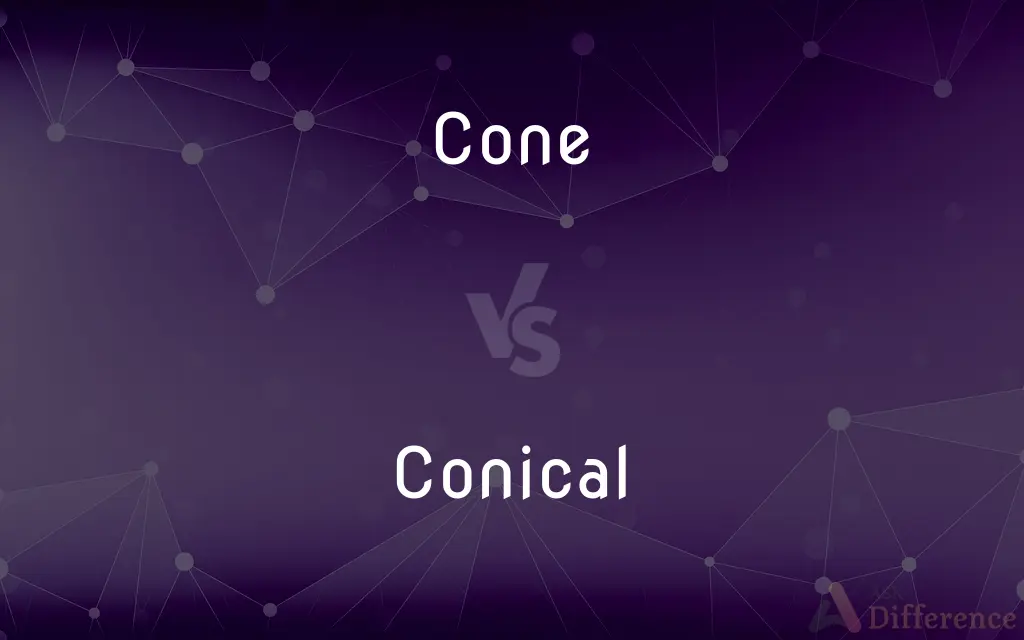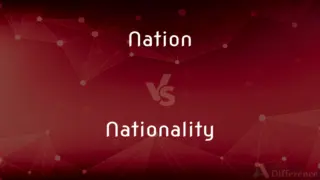Cone vs. Conical — What's the Difference?
Edited by Tayyaba Rehman — By Maham Liaqat — Updated on April 14, 2024
Cone is a three-dimensional geometric shape with a circular base and a vertex, whereas conical refers to anything having the shape or attributes of a cone.

Difference Between Cone and Conical
Table of Contents
ADVERTISEMENT
Key Differences
A cone is a solid geometric figure that has a flat, circular base and tapers smoothly from the base to a point called the vertex. Whereas conical describes the shape or characteristics of being cone-like, often used to describe objects or structures that mimic the general form of a cone.
The term "cone" can be used specifically to describe the geometric shape in mathematics or refer to objects that physically embody this shape, such as a traffic cone. On the other hand, conical is an adjective used in various contexts to describe the shape of objects, such as conical mountains or conical hats.
Cone is often used in a more literal, structural sense, highlighting objects whose entire form fits the geometric definition. In contrast, conical may refer to just the surface or part of an object resembling a cone's shape, emphasizing the tapering aspect.
In technical and scientific contexts, cone is used to define specific volumes or areas in fields such as physics and geometry. Whereas, conical is used more broadly to describe forms in biology, architecture, and engineering that resemble a cone but may not fit the strict geometric definition.
Cone is a noun, denoting either a two-dimensional profile or three-dimensional object. Conversely, conical is an adjective, describing the qualities or characteristics of an object, often implying a functional or aesthetic aspect based on the shape.
ADVERTISEMENT
Comparison Chart
Part of Speech
Noun
Adjective
Definition
A solid object with a circular base tapering to a point
Having the shape or characteristics of a cone
Usage in Geometry
Strictly defined geometric figure
Describes shape or surface resembling a cone
Usage in Everyday Context
Refers to actual objects shaped like cones (e.g., pine cones, traffic cones)
Describes objects that are cone-shaped (e.g., conical flasks)
Associated Fields
Mathematics, physics
Engineering, biology, architecture
Compare with Definitions
Cone
Cone of Vision.
Artists use the concept of a cone of vision to create perspective in drawings.
Conical
Conical Hills.
The landscape was dotted with conical hills formed by volcanic activity.
Cone
Conifer Cone.
Pine trees produce cones that contain their seeds.
Conical
Conical Shape.
The wizard's hat had a distinctly conical shape.
Cone
Geometric Cone.
A cone is a solid figure with a circular base and a pointed top.
Conical
Conical Beam.
The flashlight emitted a conical beam of light that pierced through the fog.
Cone
Ice Cream Cone.
Vanilla ice cream tastes best in a crunchy cone.
Conical
Conical Flask.
In the lab, we mixed chemicals in a conical flask.
Cone
Traffic Cone.
Cones are often used to guide traffic around construction sites.
Conical
Conical Bore.
Some musical instruments, like the saxophone, have a conical bore.
Cone
A cone is a three-dimensional geometric shape that tapers smoothly from a flat base (frequently, though not necessarily, circular) to a point called the apex or vertex. A cone is formed by a set of line segments, half-lines, or lines connecting a common point, the apex, to all of the points on a base that is in a plane that does not contain the apex.
Conical
Of, relating to, or shaped like a cone.
Cone
A solid or hollow object which tapers from a circular or roughly circular base to a point
A cone of acrylic yarn
Stalls selling paper cones full of fresh berries
Conical
(geometry) Of or relating to a cone or cones.
Cone
The dry fruit of a conifer, typically tapering to a rounded end and formed of a tight array of overlapping scales on a central axis which separate to release the seeds
A cedar cone
Conical
Shaped like a cone.
Cone
One of two types of light-sensitive cell in the retina of the eye, responding mainly to bright light and responsible for sharpness of vision and colour perception.
Conical
(cartography) Describing a map projection in which meridians are mapped to equally spaced lines radiating out from the apex and parallels of latitude are mapped to circular arcs centred on the apex.
Cone
Separate off or mark a road with traffic cones
Part of the road has been coned off
Conical
(firearms) A bullet with a conical shape.
Cone
The surface generated by a straight line, the generator, passing through a fixed point, the vertex, and moving along a fixed curve, the directrix.
Conical
Relating to or resembling a cone;
Conical mountains
Conelike fruit
Cone
A right circular cone.
Cone
The figure formed by a cone, bound or regarded as bound by its vertex and a plane section taken anywhere above or below the vertex.
Cone
Something having the shape of this figure
"the cone of illuminated drops spilling beneath a street lamp" (Anne Tyler).
Cone
A similar, spore-producing structure of club mosses, horsetails, and spikemosses.
Cone
A reproductive structure resembling a cone, such as the female inflorescence of a hop plant or the woody female catkin of an alder.
Cone
(Physiology) One of the photoreceptors in the retina of the eye that is responsible for daylight and color vision. These photoreceptors are most densely concentrated in the fovea centralis, creating the area of greatest visual acuity. Also called cone cell.
Cone
Any of various gastropod mollusks of the family Conidae of tropical and subtropical seas that have a conical, often vividly marked shell and that inject their prey with poisonous toxins, which can be fatal to humans. Also called cone shell.
Cone
To shape (something) like a cone or a segment of one.
Cone
(geometry) A surface of revolution formed by rotating a segment of a line around another line that intersects the first line. Category:en:Surfaces
Cone
(geometry) A solid of revolution formed by rotating a triangle around one of its altitudes.
Cone
(topology) A space formed by taking the direct product of a given space with a closed interval and identifying all of one end to a point.
Cone
Anything shaped like a cone.
Cone
The fruit of a conifer.
Cone
A cone-shaped flower head of various plants, such as banksias and proteas.
Cone
An ice cream cone.
Cone
A traffic cone
Cone
A unit of volume, applied solely to marijuana and only while it is in a smokable state; roughly 1.5 cubic centimetres, depending on use.
Cone
(anatomy) Any of the small cone-shaped structures in the retina.
Cone
(slang) The bowl piece on a bong.
Cone
(slang) The process of smoking cannabis in a bong.
Cone
(slang) A cone-shaped cannabis joint.
Cone
(slang) A passenger on a cruise ship (so-called by employees after traffic cones, from the need to navigate around them)
Cone
(category theory) An object V together with an arrow going from V to each object of a diagram such that for any arrow A in the diagram, the pair of arrows from V which subtend A also commute with it. (Then V can be said to be the cone’s vertex and the diagram which the cone subtends can be said to be its base.)
A cone is an object (the apex) and a natural transformation from a constant functor (whose image is the apex of the cone and its identity morphism) to a diagram functor. Its components are projections from the apex to the objects of the diagram and it has a “naturality triangle” for each morphism in the diagram. (A “naturality triangle” is just a naturality square which is degenerate at its apex side.)
Cone
A shell of the genus Conus, having a conical form.
Cone
A set of formal languages with certain desirable closure properties, in particular those of the regular languages, the context-free languages and the recursively enumerable languages.
Cone
(transitive) To fashion into the shape of a cone.
Cone
(intransitive) To form a cone shape.
Cone
(frequently followed by "off") To segregate or delineate an area using traffic cones.
Cone
A solid of the form described by the revolution of a right-angled triangle about one of the sides adjacent to the right angle; - called also a right cone. More generally, any solid having a vertical point and bounded by a surface which is described by a straight line always passing through that vertical point; a solid having a circle for its base and tapering to a point or vertex.
Cone
Anything shaped more or less like a mathematical cone; as, a volcanic cone, a collection of scoriæ around the crater of a volcano, usually heaped up in a conical form.
Now had Night measured with her shadowy coneHalf way up hill this vast sublunar vault.
Cone
The fruit or strobile of the Coniferæ, as of the pine, fir, cedar, and cypress. It is composed of woody scales, each one of which has one or two seeds at its base.
Cone
A shell of the genus Conus, having a conical form.
Cone
To render cone-shaped; to bevfl like whe circwlar segoent of a cone; as, to cone the tires of car wheels.
Cone
Any cone-shaped artifact
Cone
A shape whose base is a circle and whose sides taper up to a point
Cone
Cone-shaped mass of ovule- or spore-bearing scales or bracts
Cone
Visual receptor cell sensitive to color
Cone
Make cone-shaped;
Cone a tire
Common Curiosities
Can the term cone apply to anything other than geometry?
Yes, cone can describe various objects in real life that have a conical shape, such as traffic cones or ice cream cones.
How does conical describe an object?
Conical is used to describe anything that resembles the shape or attributes of a cone, particularly its tapering form.
Is a conical shape always perfectly geometric?
No, conical shapes in nature or design may not adhere strictly to geometric definitions but still have a tapering form.
What does a cone of vision refer to?
In art, a cone of vision refers to the visible area that appears clearly to the eye from a given point.
How is a conical beam useful in practical applications?
A conical beam can focus light or sound waves in a specific direction, useful in devices like flashlights or sonar.
What are some common objects that are conical?
Conical objects include flasks, hills, and certain types of hats.
Is conical used in specific fields?
Yes, conical is commonly used in engineering, biology, and architecture to describe objects and structures resembling a cone.
What is a conical bore in musical instruments?
A conical bore in musical instruments refers to the internal shape that tapers, affecting the instrument's sound and pitch.
What is a cone in geometry?
A cone is a three-dimensional geometric figure that tapers smoothly from a flat base to a point called the apex.
What role do cones play in mathematics?
In mathematics, cones are studied for their properties and relationships in three-dimensional space.
Can cones be found in nature?
Yes, cones are found in nature, particularly as the seed-bearing structures of coniferous trees.
How does the conical shape affect functionality in tools or containers?
Conical shapes can help in directing contents or forces, making them useful in various tools and containers like funnels.
Do conical shapes have advantages in architecture?
Conical shapes can be structurally stable and aesthetically pleasing, often used in roofs and towers for these benefits.
Why are traffic cones typically conical?
Traffic cones are conical to provide visibility and stability, ensuring they are noticeable and not easily knocked over.
Are all cones symmetrical?
Most geometric cones are symmetrical, but real-life cones may not be perfectly symmetrical due to natural or practical variations.
Share Your Discovery

Previous Comparison
Monitoring vs. Surveillance
Next Comparison
Nation vs. NationalityAuthor Spotlight
Written by
Maham LiaqatEdited by
Tayyaba RehmanTayyaba Rehman is a distinguished writer, currently serving as a primary contributor to askdifference.com. As a researcher in semantics and etymology, Tayyaba's passion for the complexity of languages and their distinctions has found a perfect home on the platform. Tayyaba delves into the intricacies of language, distinguishing between commonly confused words and phrases, thereby providing clarity for readers worldwide.
















































